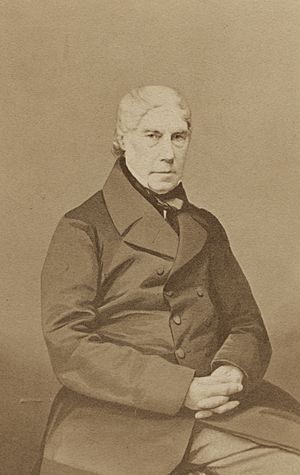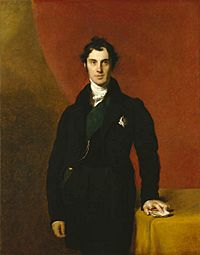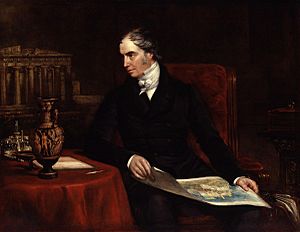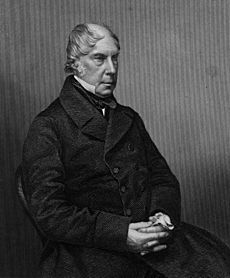George Hamilton-Gordon, 4th Earl of Aberdeen facts for kids
Quick facts for kids
The Earl of Aberdeen
|
|
|---|---|

Lord Aberdeen in July 1860
|
|
| Prime Minister of the United Kingdom | |
| In office 19 December 1852 – 30 January 1855 |
|
| Monarch | Victoria |
| Preceded by | The Earl of Derby |
| Succeeded by | The Viscount Palmerston |
| Foreign Secretary | |
| In office 2 September 1841 – 6 July 1846 |
|
| Prime Minister | Sir Robert Peel |
| Preceded by | The Viscount Palmerston |
| Succeeded by | The Viscount Palmerston |
| In office 2 June 1828 – 22 November 1830 |
|
| Prime Minister | The Duke of Wellington |
| Preceded by | The Earl of Dudley |
| Succeeded by | The Viscount Palmerston |
| Secretary of State for War and the Colonies | |
| In office 20 December 1834 – 8 April 1835 |
|
| Prime Minister | Sir Robert Peel |
| Preceded by | Thomas Spring Rice |
| Succeeded by | The Lord Glenelg |
| Chancellor of the Duchy of Lancaster | |
| In office 26 January 1828 – 2 June 1828 |
|
| Prime Minister | The Duke of Wellington |
| Preceded by | The Lord Bexley |
| Succeeded by | Charles Arbuthnot |
| Personal details | |
| Born |
George Gordon
28 January 1784 Edinburgh, Midlothian, Scotland, Great Britain |
| Died | 14 December 1860 (aged 76) St James's, Middlesex, England, United Kingdom |
| Resting place | St John the Evangelist, Great Stanmore |
| Political party | Peelite (1846–1859) |
| Other political affiliations |
Liberal (1859–1860) Conservative (1834–1846) Tory (before 1834) |
| Spouses |
|
| Children | 9, including George |
| Parents | George Gordon, Lord Haddo Charlotte Baird |
| Alma mater | St John's College, Cambridge |
| Signature |  |
George Hamilton-Gordon, 4th Earl of Aberdeen (born January 28, 1784 – died December 14, 1860) was an important British politician and diplomat. He was known for his skills in foreign affairs. He served as the Prime Minister of the United Kingdom from 1852 to 1855.
Lord Aberdeen was part of a coalition government. This was a group of different political parties working together. His time as Prime Minister led Britain into the Crimean War. This war became very unpopular, and he resigned. After that, he left politics.
He came from a rich Scottish family. His parents died when he was young. He also lost his first wife early in their marriage. He loved to travel, especially to Greece. He was very interested in ancient civilizations. He also worked hard to improve his family's estates in Scotland.
Contents
Early Life and Education
George Gordon was born in Edinburgh, Scotland, on January 28, 1784. He was the oldest son of George Gordon, Lord Haddo. His mother was Charlotte Baird. He lost his father in 1791 and his mother in 1795. He was then raised by important political figures, Henry Dundas, 1st Viscount Melville and William Pitt the Younger.
He went to Harrow School and then to St John's College, Cambridge. He earned a Master of Arts degree in 1804. In 1801, when his grandfather died, he became the Earl of Aberdeen. Before finishing college, he traveled widely across Europe. When he returned to Britain, he helped start the Society of Athenian Travellers. In 1805, he married Lady Catherine Elizabeth Hamilton.
Early Political and Diplomatic Career
In December 1805, Lord Aberdeen became a Scottish representative peer in the House of Lords. This meant he could vote in the British Parliament. In 1808, he was made a Knight of the Thistle.
After his first wife died in 1812, he joined the Foreign Service. He became the Ambassador to Austria in 1813. He signed an important agreement called the Treaty of Töplitz in Vienna. He even saw the Battle of Leipzig, where the European armies defeated Napoleon. He played a key role in European diplomacy at this time. He also helped with the negotiations that led to the Treaty of Paris (1814).
When he returned home, he was given the title Viscount Gordon. He also became a member of the Privy Council of the United Kingdom. In 1815, he married his first wife's sister, Harriet Douglas. This marriage was not as happy as his first. For the next 13 years, he was less involved in public life.
Political Roles Before Becoming Prime Minister
Lord Aberdeen held several important government jobs. He was Chancellor of the Duchy of Lancaster in 1828. Then he became Foreign Secretary under the Duke of Wellington until 1830. He resigned with Wellington over the Reform Bill of 1832.
He served as Secretary of State for War and the Colonies from 1834 to 1835. He became Foreign Secretary again from 1841 to 1846 under Sir Robert Peel. This was a very successful time for him. He settled two major disagreements with the United States. These were the border disputes for Maine and Oregon. He also worked to improve relations with France. He was trusted by Queen Victoria.
Political Opposition and Forming a Government
Lord Aberdeen resigned again with Sir Robert Peel over the Corn Laws. After Peel's death in 1850, Aberdeen became the leader of the "Peelites." These were politicians who followed Peel's ideas.
In the 1847 election, the Conservative Party had the most seats. But no single party had enough power to rule alone. Lord Aberdeen's Peelites often agreed with the Whig Party on trade issues. However, they disagreed on other matters.
In 1852, the Conservative government lost a vote of confidence. This meant they had to resign. Lord Aberdeen was then asked to form a new government. He brought together a coalition of Peelites, Whigs, and other groups. This made him the new Prime Minister in December 1852. William Ewart Gladstone became his Chancellor of the Exchequer.
Prime Minister: Leading Britain (1852–1855)
As Prime Minister, Lord Aberdeen led a government made of different political groups. His cabinet included powerful figures like Lord Palmerston and Lord John Russell. These two often disagreed, especially on foreign policy. This made it hard for Aberdeen to lead effectively.
One big foreign policy issue was Britain's relationship with France. France was now led by Napoleon III, the nephew of the famous Napoleon Bonaparte. Some British officials feared Napoleon III. They thought he might start new wars, like his uncle. Lord Aberdeen shared these fears.
However, other officials, like Lord Palmerston, were more worried about the growing power of the Russian Empire. Russia was expanding in Eastern Europe. This was seen as a threat to the Ottoman Empire, which was getting weaker.
The "Eastern Question" and the Crimean War
The "Eastern Question" was about what would happen as the Ottoman Empire declined. It became a major problem for Aberdeen's government. Napoleon III wanted to protect Christian sites in Jerusalem. The Ottoman Empire agreed to this. Russia protested, saying they had the right to protect these sites.
Britain sent a special diplomat, Lord Stratford de Redcliffe, to Turkey. He advised the Ottomans. The situation became tense. In July 1853, Russia occupied two Ottoman provinces, Wallachia and Moldavia. Aberdeen ordered the British Fleet to the Black Sea.
On October 23, 1853, the Ottoman Empire declared war on Russia. A Russian attack destroyed the Turkish fleet. Britain and France then demanded Russia leave the provinces. When Russia refused, Britain and France declared war on Russia on March 28, 1854. This started the Crimean War.
British and French troops landed in Crimea in September 1854. They fought battles like the Battle of the Alma and laid siege to Sevastopol. The Battle of Balaclava included the famous Charge of the Light Brigade.
People in Britain became unhappy with how the war was being managed. In January 1855, a motion was passed in Parliament to investigate the war. This was seen as a vote of no confidence in Aberdeen's government. He resigned and retired from politics.
Relations with the United States
Lord Aberdeen worked hard to improve relations with the United States. He got along well with Daniel Webster, the American Secretary of State. In 1842, Aberdeen sent Lord Ashburton to Washington. They settled several disputes. These included the border between Canada and Maine. They also resolved issues about the Oregon boundary and the slave trade. The Webster–Ashburton Treaty of 1842 solved most of these problems peacefully.
As Prime Minister, Aberdeen still faced some issues with the U.S. In 1854, an American ship attacked a port in Nicaragua. Britain protested this. There were also long negotiations for a trade agreement between the U.S. and Canada. This treaty was finally reached in 1854.
Legacy and Interests
Lord Aberdeen was a successful diplomat. He helped defeat Napoleon in 1813-1814. He also improved relations with France after Napoleon. He worked well with other European diplomats. He helped Britain become a key player in European politics. He also played a role in the Opium Wars with China, which led to Britain gaining Hong Kong.
However, his reputation suffered because of the problems in the Crimean War. His enemies often made fun of him.
Beyond politics, Aberdeen was a scholar. He studied ancient civilizations. He wrote a book about Greek architecture. His cousin, Lord Byron, even mentioned him in a poem. He was also the Chancellor of the University of Aberdeen and President of the Society of Antiquaries of London.
Family Life
Lord Aberdeen married Lady Catherine Elizabeth Hamilton in 1805. They had four children:
- Lady Jane Hamilton-Gordon (1807–1824)
- Lady Charlotte Catherine Hamilton-Gordon (1808–1818)
- Lady Alice Hamilton-Gordon (1809–1829)
- An unnamed son (born and died in 1810)
His first wife died in 1812. He then married Harriet Douglas in 1815. They had five children:
- George John James Hamilton-Gordon, 5th Earl of Aberdeen (1816–1864)
- General Sir Alexander Hamilton-Gordon (1817–1890)
- Lady Frances Hamilton-Gordon (1818–1834)
- Reverend Hon. Douglas Hamilton-Gordon (1824–1901)
- Arthur Charles Hamilton-Gordon (1829–1912)
His second wife died in 1833. Lord Aberdeen passed away in London on December 14, 1860. He was buried in the family vault at Stanmore church.
Images for kids
-
The Earl of Aberdeen by Thomas Lawrence in 1829
See also
 In Spanish: George Hamilton-Gordon para niños
In Spanish: George Hamilton-Gordon para niños











